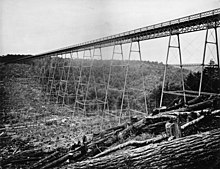Kinzua Bridge
Kinzua Bridge | |
|---|---|
 The bridge in spring 2001, before its collapse. | |
| Coordinates | 41°45′45.28″N 78°35′18.52″W / 41.7625778°N 78.5884778°W |
| Carries | Single standard gauge track |
| Crosses | Kinzua Creek |
| Locale | McKean County, Pennsylvania |
| Characteristics | |
| Design | Trestle |
| Total length | 2,052 feet (625 m)[1] |
| Width | 10 feet (3 m)[1] |
| Height | 301 feet (92 m)[1] |
| History | |
| Construction end | 1882 |
| Closed | July 21 2003 |
| Location | |
 | |
The Kinzua Bridge, also known as the Kinzua Viaduct, was a railway trestle that spanned Kinzua Creek in McKean County, Pennsylvania until it collapsed in 2003. When it was built, it was considered the tallest and longest railroad bridge in the world.[2] Before it collapsed, the Kinzua bridge ranked as the fourth tallest railway bridge in the United States.[2] It is on the list of Historic Civil Engineering Landmarks. It is located in and is the namesake of the Kinzua Bridge State Park.
Construction

The Kinzua Bridge was built by Phoenix Bridge Company for the New York, Lake Erie and Western Railway (NYLE&W) in 1882. The original Kinzua Bridge was built out of 1,552 tons of wrought iron[3] in just 94 days by a crew of less than a hundred.[1][3] The reason for the short construction time was that scaffolding was not used in the bridge's construction.[1] On its completion, the bridge was the tallest railroad bridge in the world. The Kinzua Bridge held the record until the 401-foot (122 m) Garabit Viaduct in France was completed in 1885.
Reconstruction
In 1900, because of the advances in railroad technology, the Kinzua Bridge was dismantled and replaced by a stronger steel span to accommodate heavier trains. It was rebuilt by the Elmira Bridge Company. The Erie Railroad owned the bridge after NYLE&W went bankrupt and was merged with the Erie Railroad in 1893. The Knox and Kane Railroad operated sightseeing trips across the bridge until regular commercial service ended in 1959.
State Park

William Scranton, then governor of Pennsylvania, signed legislation creating Kinzua Bridge State Park in 1963, although the park did not officially open until 1970. The bridge was named to the National Register of Historic Civil Engineering Landmarks in 1977 and ten years later, in 1987, excursion trains again began running on the bridge. The trains traveled from Kane with a trip through the Allegheny National Forest and made a stop on the bridge before returning to Kane.[4]
Destruction
In 2002, the Kinzua bridge was closed to all "recreational pedestrian and railroad usage" after it was determined that the structure was at risk to high winds.

At approximately 3:20 p.m., July 21 2003, a tornado touched down in Kinzua Bridge State Park. The storm, classified as F1 on the Fujita scale, tore down 11 of the 20 structure spans and nearby trees were snapped and uprooted. The failure was caused by badly rusted bolts holding the bases of the towers. The investigation hypothesized that the whole structure oscillated laterally 4 to 5 times before fatigue broke the base bolts. The towers fell intact in sections and suffered damage upon impact with the ground. They have been left where they fell, and it is intended to make the ruins a visitor attraction to show the forces of nature at work.[5]
References
- ^ a b c d e "History and Heritage of Civil Engineering - Kinzua Railway Viaduct". American Society of Civil Engineers. Retrieved 2007-10-02.
- ^ a b "Tornado Tears Down Historic Kinzua Viaduct". Trains. 63 (10): 25. 2003.
{{cite journal}}: Unknown parameter|month=ignored (help) - ^ a b Associated Press. "High Winds Topple Historic Railroad Bridge". Pittsburgh Post-Gazette. Retrieved 2007-10-03.
{{cite news}}: Unknown parameter|original=ignored (help) - ^ "Kinzua State Park". Pennsylvania Department of Conservation and Natural Resources. Retrieved 2007-10-04.
- ^ *Board of Inquiry Investigation. "Report on the July 21st collapse of the Kinzua Viaduct". Pennsylvania Department of Conservation and Natural Resources. Retrieved 2007-10-02.
